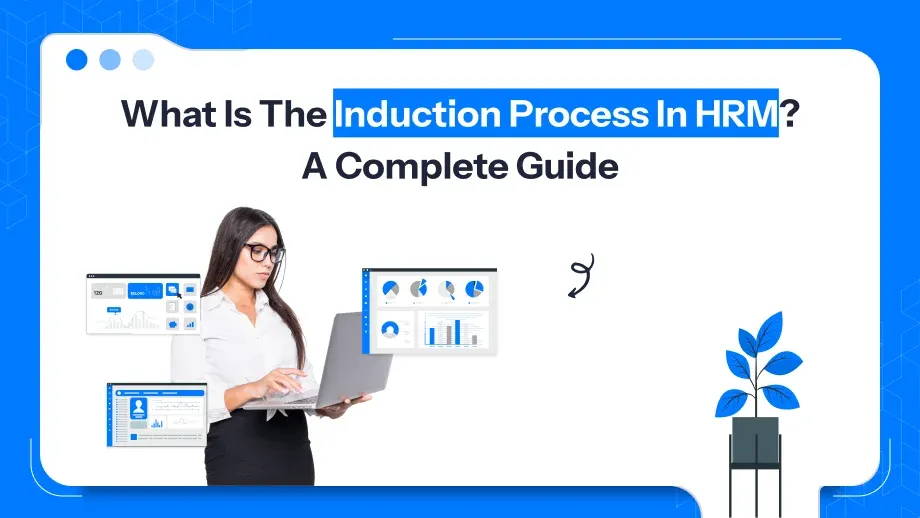
The third and very significant stage in the employee onboarding process is induction in HRM. It involves the formal meeting of a new employee with an organization, along with the acquaintance with the company culture, values, policies, and expectations. An induction process in HRM, when designed properly, helps increase retention and engagement and can even have an overall effect on productivity. This guide explains the importance of the induction process in HRM, its objectives, types of induction programs, methods, and how HRMS tools play a crucial role in streamlining the process.
What Is Induction in HRM?
Induction in HRM defines the formal processes and experiences that help new employees adapt to the world of work. The induction is more than introducing new employees to their workspace or job activities; it engages them with the company’s culture, policies, and mission to understand their roles and the company’s expectations. Induction in general begins with acceptance of the offer and continues as they start their new life with their organization.
Employee induction is important because it allows the employees to settle in the new environment with confidence and reduces stress and confusion. The process is therefore strategic in allowing proper relationships to be fostered between the employee and the company.
Objectives of Induction in HRM
Several induction objectives in HRM focus on getting the recruits to be in perfect sync with the company culture and objectives. Some of these key objectives have been discussed as follows:
Introducing company values and culture to employees:
The induction process in HRM is meant to help employees understand the culture, mission, and values of the organization. This gives the employee a greater sense of where his or her personal goals fit into the company’s overall vision. In this way, knowledge of organizational culture can ease the anxiety felt by employees while working and bring a more amiable atmosphere to the workplace.
Reducing First Day Anxiety:
A well-organized induction process in HRM largely reduces the level of stress and anxiety a new employee feels during his or her first day on the job. When he is given a proper structure and an introduction to what he will do, he’s set up to succeed. Programs for the induction of employees providing guidance and support right from the start make them feel welcome and valued.
Increasing Employee Retention:
One of the key considerations of the induction process in HRM is keeping the newcomers. An effective, well-planned induction program is proven to result in greater job satisfaction and fewer turnover rates. People will be retained with a business for a longer period if they feel that the individual or group welcomes them aboard and supports them.
Clarifying Roles and Expectations:
It helps employees understand the job roles and responsibilities along with expectations. Induction is one of the key processes in HRM that saves the organization from misunderstandings, and performance goals are clearly defined at the start.
Are you ready to streamline your induction process in HRM?
Improve and simplify employee onboarding with our HRMS software!
Importance of Induction in HRM
The induction process in HRM is something that cannot be measured because it is the root cause of the success of the employees and organizational growth. The following are the reasons why induction in HRM is necessary:
Enhanced Employee Engagement:
An effective induction program for the employee engages a new hire the moment he walks into the organization. It keeps him feeling welcomed, informed, and involved as the induction process gives him the feeling of belonging, which consequently results in a higher level of employee engagement and good performance at the workplace.
Stronger Employee Retention:
The primary benefits of a proper induction process are increased retention. When employees understand their value to the organization by being properly inducted into the company, this can help cut down early turnover rates.
Effective Integration into the Team:
Induction, therefore, encompasses not only paperwork and perusal of policy documents but also introducing new people to the group. The induction process in HRM helps new workers get integrated effectively into the company, develop bonds with colleagues, and create an atmosphere of teamwork.
Policy and Procedure Understanding:
This is an important part of the induction process in HRM; it exposes the employee to the policies of the company, benefits, and procedures. Through this, the employees are more likely to uphold the guidelines which eventually results in the success of the organization.
The Three Phases Of Induction
General Induction
This is the domain of the HR department. At this stage, the new employee is exposed to the wide scope of the organization. The company’s mission, vision, and values are given to the new hire to understand the purpose and direction of the company. The employee is also briefed on some organizational policies about facilities, compensation structure, promotion procedures, grievance management, and other key rules that govern their employment.
Specific Induction
The direct supervisor or manager retains the responsibility for specific induction. This phase focuses on job-specific information and ensures the new employee is adequately prepared for the particular role. The employee is presented with the workstation, tools, and resources they will apply for their work. The supervisor will explain the duties, rights, responsibilities, and authority of the employee within the organization. This stage is intended to help the employee settle into his or her job, team, and work environment, thus making him or her feel comfortable and productive.
Follow-up Induction
This is the second induction phase after the initial induction stages. It is very important in reinforcing understanding. The purpose of this phase is to ensure that the new employee has understood all the information provided during the earlier phases. This phase helps identify any gaps in knowledge or understanding and addresses them promptly. This phase is conducted by the employee’s supervisor or a dedicated specialist and evaluates the overall effectiveness of the Induction and onboarding program to determine whether additional support or clarification is needed to help the employee succeed in their role.
Types of Induction in HRM
Various types of induction in HRM depend on the company’s nature and employee needs. Each has its merits and can be used to fit individual organizational structures:
Formal Induction:
The formal induction process is very structured, often involving a series of sessions where employees are introduced to the company’s policies, organizational structure, and job-specific training. This is commonly applied in larger organizations where the process needs to be standardized.
Informal Induction:
In smaller organizations, informal induction might very well be more the case. New employees can complete their induction process remotely using HRMS tools and digital platforms, allowing flexibility and accessibility, especially for geographically dispersed teams.
Job-Specific Induction:
Job-specific induction focuses on role-specific responsibilities, training, and expectations. This type of induction helps employees understand the exact skills and knowledge required for their position, ensuring they are prepared for their tasks.
Online Induction:
With the rise of remote work, online induction has become an essential method. Using HRMS tools and digital platforms, new employees can complete their induction process remotely, allowing flexibility and accessibility, especially for geographically dispersed teams.
Methods of Induction in HRM
The methods of induction in HRM vary depending on the company’s goals and the employee’s needs. Here are a few common methods:
Face-to-Face Orientation:
Face-to-face orientation is the most traditional approach that involves welcoming new employees, presenting the values of the company, introducing them to the key team members, and relevant training. This method remains popular because it offers personalized interaction and guidance.
E-Learning and Online Tools:
Many companies now utilize HRMS tools to provide an online, automated induction process in HRM. Through HRMS solutions, employees can access training materials, complete documents, and get familiar with company policies at their own pace. This method is especially beneficial for remote employees.
On-the-Job Training:
On-the-job training is an experiential approach where new employees learn by doing their job under supervision. This method is highly effective for roles that require practical knowledge and skills.
Mentoring or Buddy System:
Pairing new employees with a mentor or buddy can significantly ease their induction process in HRM. The mentor helps the new hire navigate the company’s culture and policies while providing ongoing support during the early days.
How HRMS Software Can Streamline the Induction Process?
Using HRMS and payroll software for induction processes has become increasingly important for organizations. Here’s how HRMS tools can streamline the induction process in HRM:
Automating Documentation:
HRMS solutions automate the process of documentation by offering one central location where new employees can submit forms, sign contracts, and complete any other paperwork necessary while reducing administrative workload on HR teams.
Training and Development:
HRMS software can host training modules, monitor completion, and even assign particular training courses for new hires. In this manner, employees become job-ready immediately at the time of joining the organization.
Centralized Communication:
Information about the induction process in HRM, like schedules, resources, and contacts, can all be stored within a single, accessible platform. By using HRMS tools, all the relevant information that the employee needs to perform his tasks can be given in one go, thus obviating the chances of confusion and delay.
Employee Engagement Tracking:
With the right HRMS tools, HR departments can track new employee engagement levels during induction. This includes feedback surveys, task completion, and performance metrics, through which HR teams can improve the induction process.
Conclusion
The induction process in HRM is important for the welcoming, informing, and integrating of new employees into their roles. A well-structured induction process leads to higher engagement levels among employees, and retention rates, and lays a foundation for long-term success. Organizations can make the induction process more efficient and impactful for both the new employee and the company by having the right tools, such as HRMS and payroll software.






